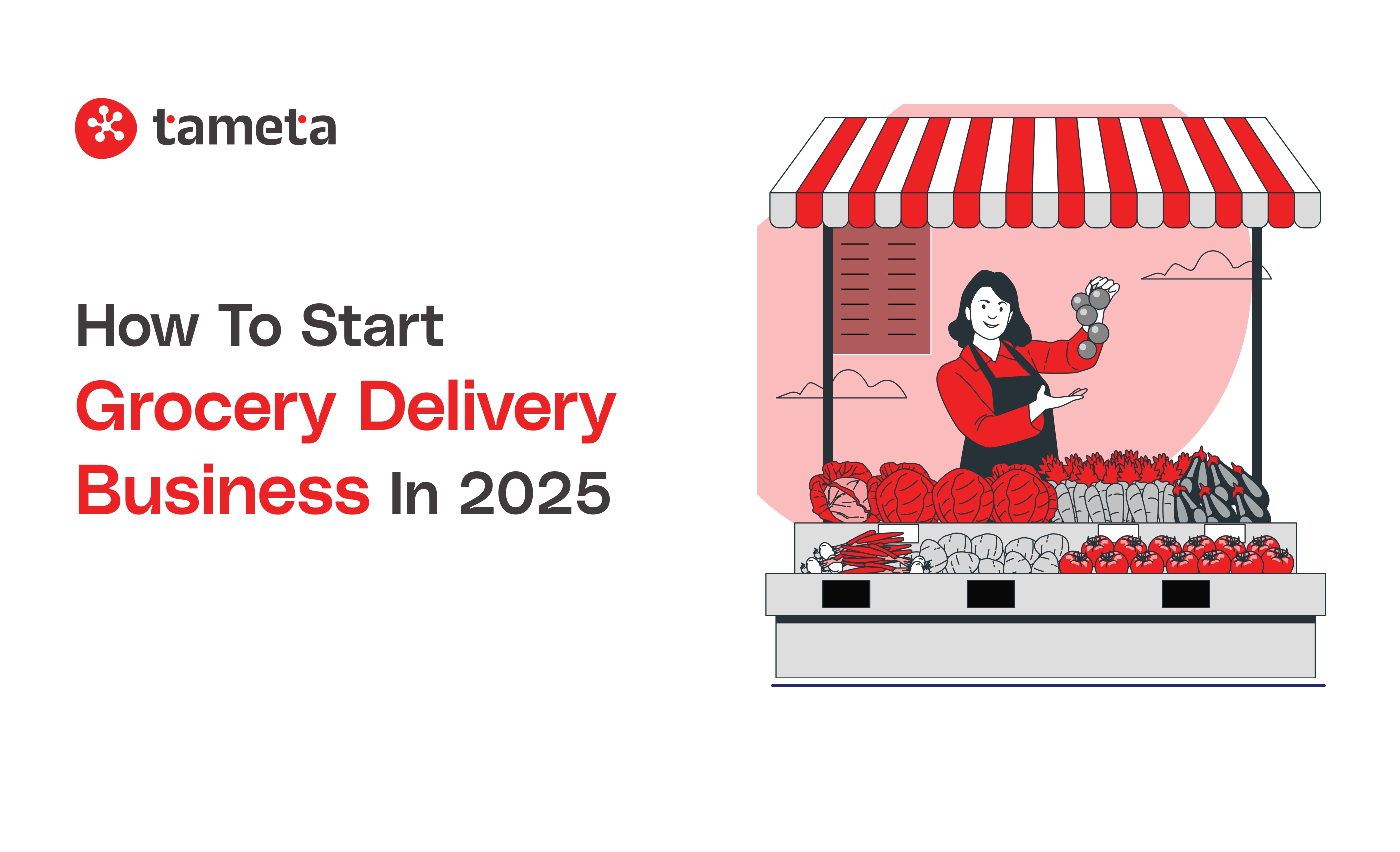Starting a grocery delivery business in 2025 can be rewarding and profitable. With people relying more on convenience and technology, this business has immense growth potential. If you are a grocery store owner or planning a startup, this guide will walk you through everything you need to know.
-
Customer Preference: 70% of consumers prefer same-day grocery delivery (source: NielsenIQ).
-
Mobile Usage: Over 60% of grocery orders are placed via mobile apps (source: Business Insider).
-
Revenue Growth: Online grocery sales grew by 15% year-over-year in 2024 (source: Statista).
-
Sustainability Trends: 40% of customers prefer eco-friendly packaging for their grocery deliveries.
Why Start a Grocery Delivery Business?
The demand for grocery delivery services has skyrocketed in recent years, according to a report from Statista, the online grocery market is expected to reach $243 billion globally by 2025. This presents a golden opportunity for entrepreneurs to tap into this growing market.
Some key reasons to consider starting a grocery delivery business include:
-
Increased Convenience: Customers prefer the ease of ordering groceries from their homes.
-
Growing Online Market: More people are comfortable shopping online.
-
Recurring Revenue: Groceries are essential, so customers order regularly.
-
Scalable Model: Start small and expand as your business grows.
Step-by-Step Guide to Start a Grocery Delivery Business
1. Research and Planning
Before jumping in, conduct thorough research to understand the market, your competitors, and your target audience. Consider:
-
Market Trends: Look for patterns in the grocery delivery industry, including customer preferences for delivery times, payment methods, and popular product categories.
-
Customer Needs: Identify pain points like unavailability of products, delayed deliveries, or lack of variety, and ensure your business addresses these issues.
-
Competitor Analysis: Study competitors like Instacart or local grocery apps. Note their pricing models, unique features, and customer feedback to understand how you can differentiate your service.
-
Regulations and Licensing: Research the legal requirements, licenses, and permits needed for running a grocery delivery business in your area.
-
Technology Trends: Look into the latest technologies being used in the industry, such as AI for personalized recommendations or blockchain for supply chain transparency.
2. Create a Business Plan
Your business plan should include:
-
Business Model: Will you offer on-demand delivery, subscription services, or both? Consider hybrid models that combine one-time orders with recurring subscriptions.
-
Revenue Streams: Explore diverse revenue streams, including delivery charges, subscription fees, partnerships with local stores, and advertising on your platform.
-
Target Audience: Clearly define your audience segments. For example, working professionals may prioritize speed and convenience, while families might value cost savings and variety.
-
Initial Budget: Calculate costs for app development, marketing, logistics, and initial inventory—factor in contingency funds for unforeseen expenses.
-
Marketing Strategy: Include detailed plans for online and offline marketing to create brand awareness and attract early customers.
-
Scalability Plan: Describe how you will scale your operations as demand increases, such as expanding delivery areas, adding more delivery personnel, or integrating advanced technology.
-
Risk Management: Outline strategies for handling potential risks like delays, supply chain issues, or high competition.
"Success is the sum of small efforts, repeated day in and day out." – Robert Collier
Tameta Tech Helps to Build the Right Technology
Technology plays a vital role in the success of your grocery delivery business. Here's what you need:

1. Mobile App for Grocery Delivery
Your app should be user-friendly and packed with features like:
-
Easy registration.
-
Search and filter options.
-
Real-time tracking of orders.
-
Multiple payment options.
-
Reviews and ratings.
Partnering with a startup development company can help you create an app tailored to your needs.
2. Vendor Management Software for Grocery App
Managing vendors is critical. Vendor management software allows you to:
-
Track vendor performance.
-
Ensure stock availability.
-
Manage pricing and deals.
3. Inventory and Stock Management Software
Stock management is essential for avoiding shortages or overstocking. This software helps you:
-
Track inventory levels in real time.
-
Generate low-stock alerts.
-
Manage expiration dates for perishable goods.
4. Website Development for Grocery Delivery
While mobile apps are essential, a professional website is equally important. Ensure your website includes:
-
A clear call-to-action (CTA) for orders.
-
Integration with your app.
-
SEO optimization to attract organic traffic.
5. Admin Dashboard Development for Grocery Delivery
Your admin dashboard is the control center of your business. It should allow you to:
-
Manage customer orders.
-
Monitor delivery partner performance.
-
Track payments and refunds.
-
Analyze sales data.
6. Delivery Partner App Development
Your delivery team needs their app to:
-
Receive order notifications.
-
Update delivery status.
-
Communicate with customers.
-
Access optimized delivery routes.
Hiring the Right Team
You’ll need a reliable team to manage operations:
-
Delivery Personnel: Hire experienced or train new delivery partners.
-
Customer Support: Ensure prompt responses to customer inquiries.
-
Marketing Team: Promote your grocery delivery business effectively.
-
Tech Experts: Maintain your app and website.
Marketing Your Grocery Delivery Business
Marketing is key to attracting customers. Here are some tips:
-
Social Media Marketing: Promote your services on platforms like Instagram, Facebook, and Twitter.
-
Local Partnerships: Collaborate with local grocery stores.
-
Google Ads: Use Google Ads to Run targeted campaigns for people searching for grocery delivery services.
-
Referral Programs: Offer discounts for customers who refer your app.
-
Content Marketing: Share tips and recipes to engage your audience.
Challenges in Grocery Delivery Business
Like any business, the grocery delivery business has challenges. Here’s how to tackle them:
-
High Competition: Offer unique features like faster delivery or better deals.
-
Inventory Management: Use advanced inventory and stock management software.
-
Customer Retention: Run loyalty programs and offer personalized deals.
-
Delivery Logistics: Use GPS tracking and route optimization tools.
Important Tips for Success
-
Start Small: Focus on a single area before expanding.
-
Offer Subscriptions: Encourage customers to subscribe for weekly or monthly deliveries.
-
Feedback is Key: Regularly ask customers for feedback and implement improvements.
-
Use Data: Leverage sales data from your admin dashboard to make informed decisions.
Also Read - How to Turn Your Idea Into a Real Startup
Real-Life Success Stories
To inspire you, here are examples of successful grocery delivery businesses:
-
Instacart: Revolutionized grocery delivery by partnering with local stores.
-
BigBasket: Dominates the Indian market with a robust delivery network.
-
Amazon Fresh: Combines technology and logistics for seamless service.
Key Technologies to Stay Ahead in 2025
-
Artificial Intelligence (AI): Predict customer preferences and suggest products.
-
Chatbots: Provide 24/7 customer support without human intervention.
-
Blockchain: Enhance supply chain transparency.
-
Data Analytics: Analyze customer behavior to optimize offerings.
-
Voice Commerce: Allow customers to place orders using voice commands.
How to Choose a Development Partner
When building your app and website, work with a reliable startup development company. Look for:
-
Experience: Have they developed similar apps before?
-
Portfolio: Review their past projects.
-
Client Feedback: Check reviews and testimonials.
-
Customization Options: Ensure they can tailor the app to your unique business model.
Financial Management Tips
-
Automate Billing: Use software to manage invoices and payments.
-
Optimize Delivery Costs: Use analytics to plan efficient routes.
-
Budget for Marketing: Allocate at least 20% of your budget to promotion.
-
Monitor Cash Flow: Regularly analyze income and expenses to ensure profitability.
Expansion Ideas
-
Specialty Groceries: Offer organic or locally sourced products.
-
Meal Kits: Include pre-portioned ingredients for cooking.
-
Subscription Plans: Weekly or monthly grocery bundles.
-
Partnerships: Collaborate with restaurants for surplus inventory sales.
-
Dark Stores: Operate small warehouses in key locations for faster delivery.
FAQS
1. How much does it cost to start a grocery delivery business?
- Starting a grocery delivery business can cost anywhere between $10,000 to $50,000, depending on the size and scale of your operations. Costs include app development, website creation, marketing, and hiring delivery staff. Start small and scale as your business grows.
2. Do I need a physical grocery store to start this business?
- No, you don’t need a physical store. You can partner with local grocery stores to source products. Alternatively, you can set up your storage facility or warehouse to manage inventory.
3. How can I compete with big companies like Instacart or Amazon Fresh?
- Focus on providing excellent customer service, faster deliveries, and unique features. Offering local and organic products or a subscription-based service can help differentiate your business from larger competitors.
4. What features should my grocery delivery app include?
- Your app should include features like easy registration, a search and filter option, real-time order tracking, secure payment methods, and customer reviews. User-friendly design and speed are key to retaining customers.
5. How do I find delivery personnel for my business?
- Start by hiring locally. Advertise through job portals, community boards, or social media. Train your delivery staff to handle groceries carefully and provide excellent customer service.
Final Words
Starting a grocery delivery business in 2025 is an excellent idea if you’re ready to embrace technology and customer-centric strategies. By investing in the right tools like vendor management software, inventory and stock management software, and a well-designed app, you can stay ahead of the competition. Ensure your business prioritizes customer satisfaction and continuous improvement to thrive in this competitive industry.
Looking to start your grocery delivery business in 2025? Tameta Tech is your trusted startup development partner! We create user-friendly apps, websites, and dashboards tailored for your success. From idea to launch, we’ve got you covered. Let’s bring your dream business to life. Contact Tameta Tech today!








